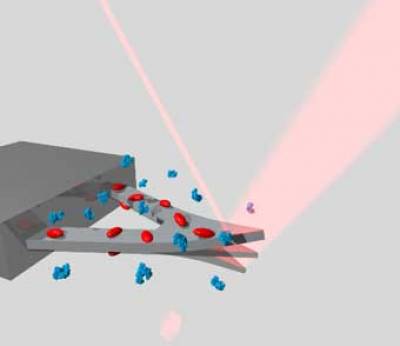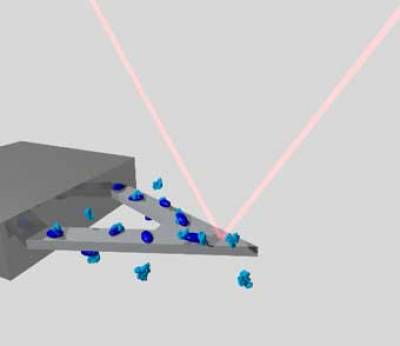Nanotechnology provides an exciting opportunity in the world of diagnostics. Current methods for diagnosing TB and detecting resistant strains of TB are hampered by cost, speed or sensitivity. With this in mind, our work is focussed on using nanotechnology to create a diagnostic tool which will provide an antibiogram in a matter of minutes. The technology is based on using micrometer-sized cantilevers which act as tiny spring boards. The bending or oscillation of the cantilevers can be measured extremely accurately using a laser.
This system is sensitive enough to measure nano-scale mechanical vibrations which are produced by living bacteria immobilised on the cantilever. These fluctuations have been found to stop after the bacteria are killed by exposure to antibiotics, thus providing a read out of sensitivity to a given antibiotic (see Fig 1). We are looking to explore this phenomenon and develop this into a point of care diagnostic. As this technique does not require waiting for the growth of the bacteria, it lends itself particularly to the case of slow growing M. tuberculosis.
With reduced time to detection of MDR TB and XDR TB, the correct antibiotic regime can be implemented sooner, helping to improve patient outcomes, reduce health care associated costs, and prevent the development of resistance.


Nano-scale vibrations of living bacteria causing the cantilever to fluctuate (left), which disappear after exposure to an antibiotic to which the bacteria are sensitive (right).
If the fluctuations continue, this would suggest the bacteria are resistant to that particular antibiotic.
Credit:
Natascha Kappeler and Rachel McKendry, from "Sensors: Good vibrations for bad bacteria" (Nature Nanotechnology, 2013).
This work is done in association with i-sense, EPSRC IRC in Early-Warning Sensing
Systems for Infectious Diseases, led by UCL Professor Rachel Mckendry. For
further information, please visit i-sense
Contact:
- Kailey Nolan k.nolan@ucl.ac.uk (i-sense Communications and Administration Officer)
- Natascha Kappeler n.kappeler@ucl.ac.uk
- Isabel Benet isabel.bennett.14@ucl.ac.uk
 Close
Close


